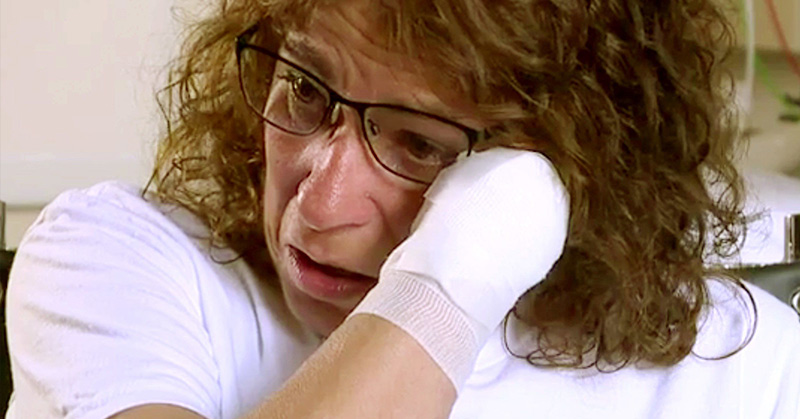An infection as the result of dog saliva caused an Ohio woman to spend 10 days in a coma, 80 days in the hospital, and ultimately lose her arms and legs.
Marie Trainer says she has no memory of what happened but remembers feeling sick. She woke up from a medically-induced coma to discover that her arms and legs had been amputated.
Doctors discovered that Trainer tested positive for capnocytophaga, a species of bacteria that lives in the mouths of some mammals, including dogs, cats, humans, and rabbits. Trainer and her husband had just returned home from a vacation and say she felt nauseous and had back pain with fluctuating temperature.
After going to the emergency room, Trainer’s condition deteriorated rapidly. She developed sepsis, the body’s response to a severe infection that can lead to organ failure and even death.
After no improvement, Trainer developed gangrene, where tissue begins to die as the result of infection [2]. Trainer began developing blood clots and doctors had to amputate her limbs to prevent her from dying.
Trainer, who has two dogs, says they lick her all the time. “It was very hard to find out that they had to remove my legs and my arms,” she says, which might just be the biggest understatement of the year.
What Is Capnocytophaga?
Capnocytophaga is a type of bacteria that lives in the mouths of some mammals, including dog saliva, but most commonly cats and dogs. There are different species of capnocytophaga, and some of these are present in the oral cavities of humans as well [3].
C. canimorsus and C. cynodegmi are the species most associated with animals, and while they can make humans sick, they don’t negatively affect the animals [4].
It’s rare, but capnocytophaga can spread to people and cause an infection that can result in severe complications, including sepsis. People with a weakened immune system are at greater risk, according to the Centers for Disease Control and Prevention (CDC). These include people who drink alcohol excessively, have had their spleens removed, or have HIV or cancer [5].
While capnocytophaga is usually transmitted through a bite or scratch, people can get infected merely from “close contact with dogs or cats”. The majority of reported infections occur in tissues around the mouth and throat, including the gums, nose, throat, and lungs, but also through the eyes. The bacteria then get into the bloodstream, which can lead to an infection [6].
Capnocytophaga can cause life-threatening complications, including heart attack, kidney failure, and, as in Trainer’s case, gangrene. Some infections can progress rapidly and cause sepsis within 24 to 72 hours after symptoms start, although symptoms can take anywhere from three days to two weeks to present themselves.
In Trainer’s case, doctors believe her two dogs must have licked a small scrape on her arm which in turn lead to a life-threatening infection.
Symptoms of the Condition
As with any medical condition, symptoms can vary, but may include [7]:
- Fever
- Stomach pain
- Diarrhea
- Blisters, swelling, redness, pus, or pain around the wound within hours after the bite or scratch
- Vomiting
- Headache
- Confusion
- Muscle or joint pain
How to Minimize Your Risk of Contracting the Bacteria from dog saliva
As alarming as it sounds, 30 percent of people who develop a serious infection as the result of capnocytophaga die [8].
Fortunately, this illness is rare—since 1976, approximately 200 cases have been reported worldwide, but this number could be higher, as it’s not always reported and not always identified by physicians when capnocytophaga has been the result of sepsis or other life-threatening conditions [9].
It’s estimated that up to 84 percent of cats and 86 percent of dogs have this bacteria [10].
And, for my fellow bunny owners out there, rabbits can have it too, although transmission from rabbits is far less rare than that from dogs [11].
How to Prevent It
First, preventing bites and scratches is important. Train your pet and understand how to handle them—most pets lash out because they feel unsafe or threatened. If you have young children, teach them how to act around animals, and never introduce them to a new pet without doing so.
When getting a new animal, always have them examined by an experienced vet to ensure they don’t have any physical or behavioral problems that could lead to an increased risk of biting or scratching. Animals can also lash out if they are in physical pain.
Do not let animals lick your face (am I the only one who thinks that’s disgusting anyway?) or wounds. It’s a good idea to keep any broken skin covered by clothing or bandages when handling an animal to prevent potential transmission.
What to Do If You Are Scratched or Bitten With Dog Saliva
If you have experienced a scratch or a bite (hey, we’ve all been there!), wash the area as soon as possible with soap and water. If it’s a wild animal and you’re not sure if it’s been vaccinated for rabies, you may want to call your doctor.
Remember, some people don’t even need to be bit to experience a transmission. Even licking can expose you to capnocytophaga. If you begin experiencing symptoms within two weeks, seek emergency medical care and tell your provider that you’ve been scratched, bitten, or licked by an animal recently.
Should I Be Worried About My Pet?
Capnocytophaga is normally present in the mouths of animals, so you don’t need to be worried about your pet having the bacteria.
Even if your pet is bitten or scratched by another pet, transmission in this case would be very rare, but obviously if you have concerns about your pet’s wellbeing, you should always follow up with your experienced veterinarian.
In Trainer’s case, her infection progressed so rapidly that doctors couldn’t save her arms and legs. Trainer says her husband has been helping to take care of her, including feeding and dressing her. They won’t be getting rid of their dogs, and she’ll be exploring prosthetic options to be able to walk again.
Keep Reading: Holland breaks record as first country ever to have zero stray dogs
Sources
- ‘Gangrene’ Hopkins Medicine
- ‘Capnocytophaga species’ Antimicrobe A. Jolivet-Gougeon.
- ‘Prevention of Capnocytophaga Infection’ CDC
- ‘What is Capnocytophaga?’ Worms And Germs
- ‘Pathogen Safety Data Sheets: Infectious Substances – Capnocytophaga spp.’ Canada
- ‘Woman Wakes from Coma to Find Legs and Arms Have Been Amputated Due to an Infection from Dog Saliva’ People Robyn Merrett. Published August 01, 2019

